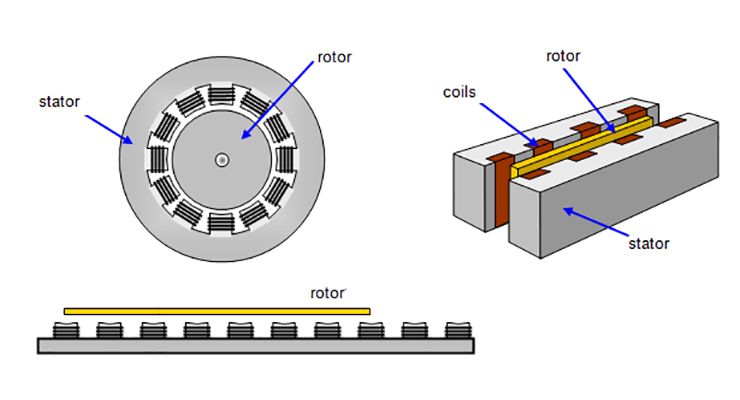PERMANENT MAGNET MATERIALS & LINEAR INDUCTION MOTOR
The market for
hard magnetic materials is nowadays dominated by two families of materials, the
hexagonal ferrites and Nd–Fe–B (Fig. 13.1(a)). Their production volumes and
costs are quite different, but each holds roughly half the market.
Ferrites are
produced throughout the world, but Nd–Fe–B production is concentrated in China,
where there are abundant rare-earth reserves. Most magnets are produced as
sintered blocks or other simple shapes, but increasing quantities of
polymer-bonded material, suitable for making complex shapes by injection
moulding, are manufactured. The maximum energy product doubled roughly every 12
years over the course of the twentieth century (Fig. 1.13).
Consequences for
permanent magnet device design have been dramatic, as illustrated in Fig. 13.4.
The devices shrink as higher energy-product magnets become available, their
configuration changes and the number of parts can be reduced. The advantage of
magnets over coils in small structures can be appreciated by comparing a small
discshaped magnet with a coil having the same magnetic moment. A magnetized
cylinder with diameter 8 mm and height 2 mm made of a material with M = 1 MA
m−1 has m ≈ 0.1Am2. The equivalent current loop, m = IA would require 2000
ampere-turns, an impossible demand in such a small space! There has been no
further doubling of (BH)max since 1996, and there seems to be little scope for
further dramatic improvements of bulk material, barring the development of
practical oriented hard/soft nanocomposites. Properties of some typical magnets
are shown in Table 13.3.
The data are
for dense oriented magnets, made from sintered uniaxial ceramic ferrite or
metallic alloy powder. These magnets have a microstructure in which the c axes
of the individual crystallites are aligned by applying a magnetic field during
processing. All except alnico are true permanent magnets, in the sense that the
magnetic hardness parameter κ, defined by (8.1), is greater than unity. The
(BH)max values achieved fall short of the theoretical maximum µ0M2 r /4 because
of nonideal loop shape. Two values of coercivity are listed, one is the
‘intrinsic’ coercivity iHc measured on the M(H) loop, the other, BHc, is the
coercivity measured on the B(H) loop.
Ferromagnetic
microstructures are illustrated in Fig. 13.5. Sometimes the additional process
steps needed to produce an oriented magnet cannot be justified economically. It
may be cheaper to make more of an isotropic magnet with inferior magnetic
properties. The c axes of the individual crystallites are random and, if
interactions between crystallites are neglected, the remanence is Ms cos θ = 1
2Ms, where θ is the angle between the c axis and the direction of
magnetization. Components made of ceramic or sintered metal are shaped by
slicing or grinding. Polymer bonding allows for more versatility in shaping
magnetic components. A coercive powder is mixed with a binder, with a fill
factor fm of 60–80 vol%. The mixture is die-pressed, injection moulded,
extruded or rolled into the required shape. The c axes of the crystallites in
the powder may be oriented in the binder by using a magnetic field in order to
augment the remanence. Since Mr is now fmMs cos θ , where θ is the angle
between the c axis and the aligning field, even a fully aligned powder with fm
= 0.7
Temperature
coefficients around ambient temperature are listed in Table 13.5. Not all the
loss is recoverable on returning to ambient temperature; irreversible losses
are associated with thermal cycling. Maximum service temperatures for different
materials are included in the table. Ferrites and rare-earth magnets with wide,
square hysteresis loops have the property that the field of one magnet does not
significantly perturb the magnetization of a neighbouring magnet.
This is because
the longitudinal susceptibility is zero for a square hysteresis loop, and the
transverse susceptibility is Ms/Ha, which is only of order 0.1, since the
anisotropy field Ha = 2K1/µ0Ms is much greater than the magnetization. Rigidity
of the magnetization means that the superposition of the induction of
rare-earth permanent magnets is linear and the magnetic material is effectively
transparent, behaving like vacuum with permeability µ0.
Transparency and rigidity of the magnetization greatly simplify the design of magnetic circuits. There is no need to worry about the effect of one magnetic segment on another. Magnet cost is often critical for applications. Ferrite and Nd–Fe–B magnets are both produced in large quantities – roughly 1 million tonnes of ferrite and 50 000 tonnes of Nd–Fe–B in 2008. The properties of the two are quite different, and numerous grades of Nd–Fe–B are available, featuring high coercivity or high remanence, with energy products ranging from 250 to 450 kJ m−3. A very rough guide to cost is $1 per joule of stored energy. Hence, from the data in Tables 13.3 and 13.4, the costs of oriented ferrite and Nd–Fe–B work out at about 7$ kg−1 and 40$ kg−1, respectively. Ferrite is even cheaper than this but the cost of sintered Nd-Fe-B is about twice that estimate.

Related Articles
Lesson meta keywords and meta description:
Write a public review